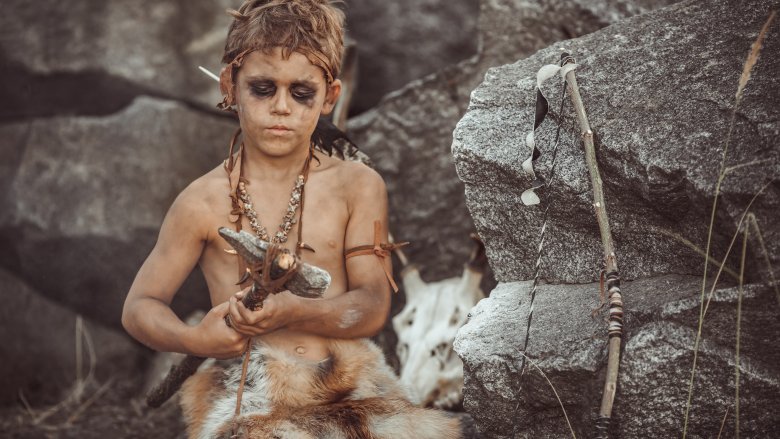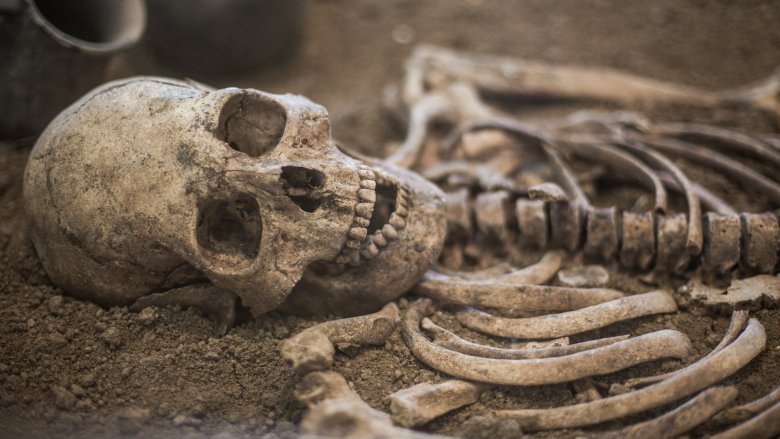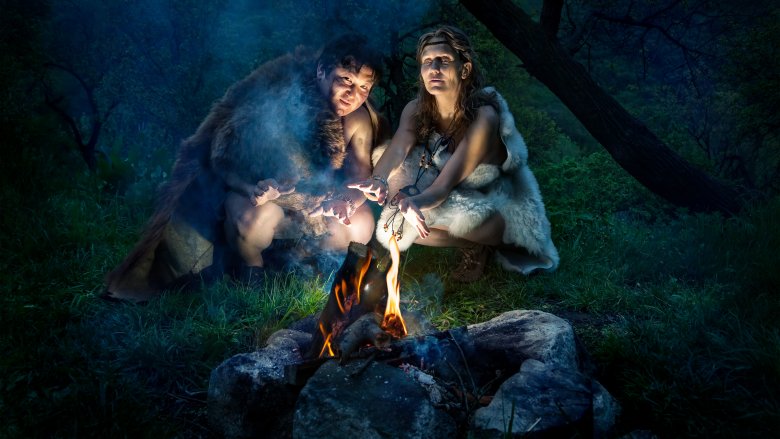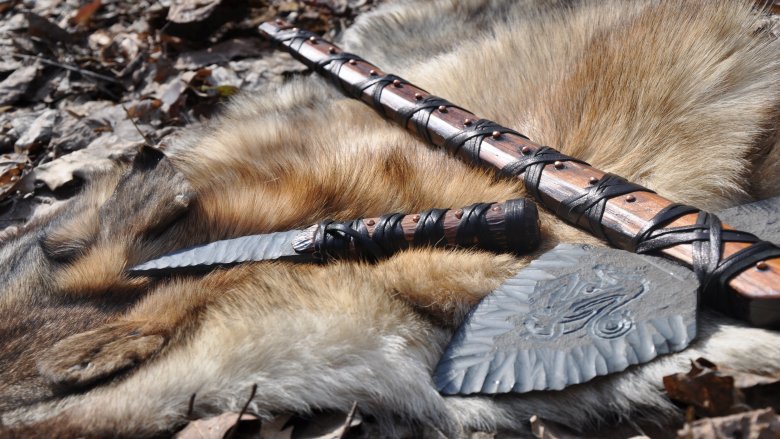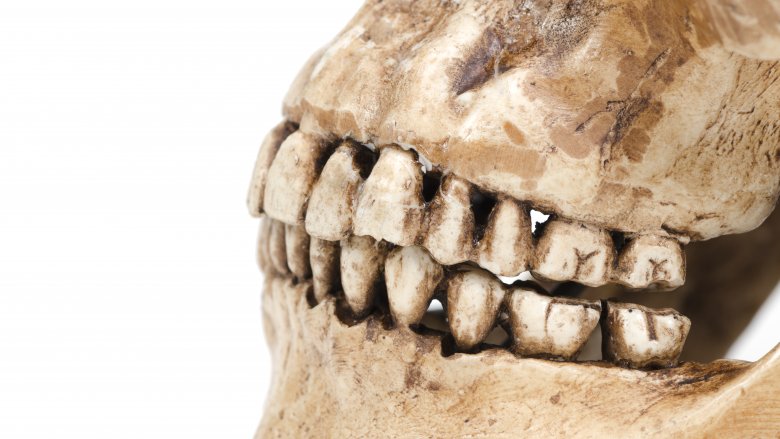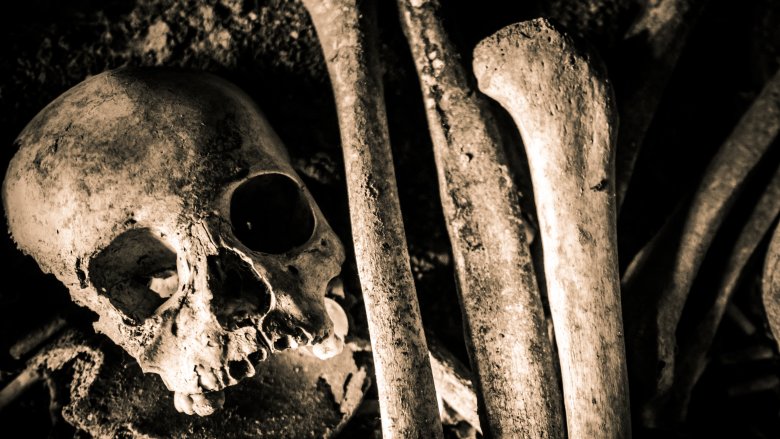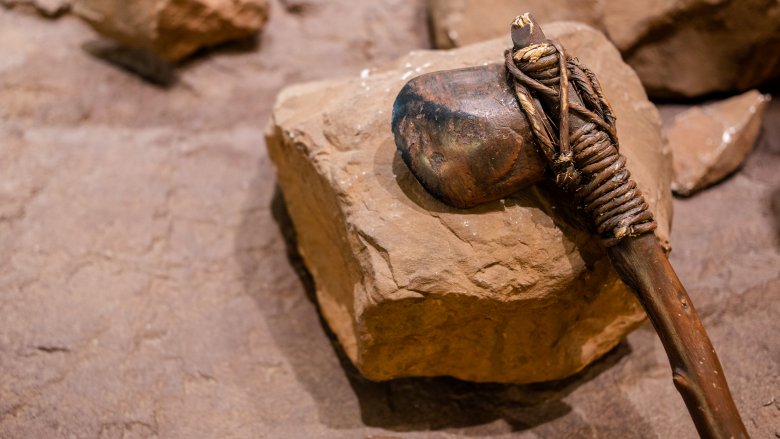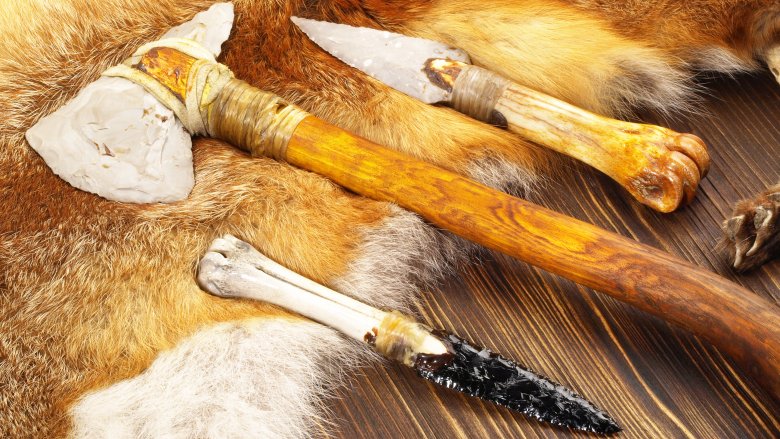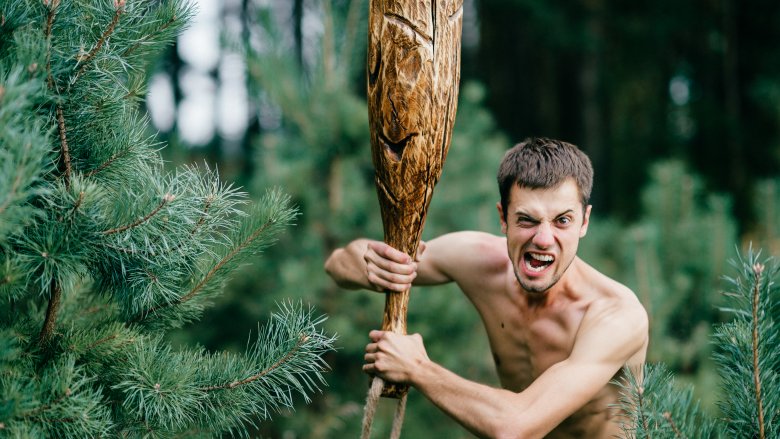Why You'd Never Survive Life During The Stone Age
Looking for the very definition of "simpler times"? Looking to get away from all the burdens of modern life? Want to say "goodbye" to internet trolls, weekend responsibilities, lists of chores, and dinner out with people you really, really don't want to spend time with? The Stone Age might just be the answer.
It's the literal definition of "simpler," and mankind's arrested development had us stuck there for a shockingly long time. The Stone Age is the period in our collective history defined by our use of stone tools, the earliest of which date back 3.3 million years. It took a few million more years before mankind finally started to move beyond that, and from there, it was only a relatively short hop, skip, and a jump to smartphones and Call of Duty. That's weird and impressive at the same time.
Mankind has spent roughly 98 percent of its existence relying only on themselves and tools made of antler, bone, and stone... just let that sink in a bit, especially when it starts feeling like life would have been better then. More straightforward. Less stressful. If it helps, you would have had a miserable time of it then, too.
Hold still, this'll only hurt for a very short minute...
It's incredible what modern medicine can do. Heck, doctors can even perform full face transplants now. But that's with the help of anaesthetic, very precise tools, and a lot of computers. Mankind didn't have any of that in the Stone Age — they didn't even really have the basic knowledge of anatomy that came much later — but they were still performing surgery. Archaeologists have the proof, too, and it's pretty... squicky.
Freiburg University archaeologists were working in France when they excavated a group of 7,000-year-old graves. Among the bodies was one belonging to a man who had been about 50-years-old when he died, and he had two holes in his skull. The wounds were very deliberate and very clean, with none of the surrounding cracks and damage expected from a violent injury or accident. One of the holes was about 2.5 inches, the other around 3.5 inches.
Oh, it gets worse. Archaeologists say (via Discover) that the wounds were very clearly made at two different times, and that the man showed somewhere between six months and two years' worth of healing. Flint tools — which are sharper than today's tools — were likely used, and there's a bit of good news? They practiced. According to CNN, archaeologists have uncovered evidence that early surgeons were practicing on cows sometime around 7300 BC. Fun fact: anesthesia wasn't a regular thing until 1846, so there's that.
Would you like your Stone Age ribs well done or still bloody?
Stone Age people weren't the foodies many claim to be today, but they still needed to eat. And eat, they did. There's no question about the fact Stone Age people ate other people. University of Valencia (via ArsTechnica) anthropologists discovered 10,000-year-old human bones in a cave on the coast of Spain that showed very distinct markings indicating human meat was on the menu. The evidence is striking, and includes human bones with bite marks. If it helps, there was no sign of violence, so the people were probably already dead before they were dinner.
They weren't the only ones, either. According to The Guardian, archaeologists have been able to find just when Stone Age people moved to Britain: about 14,700 years ago, when they settled in Somerset. And they had perfected the art of butchering to get the most amount of meat possible, and they used the same techniques on the bones of men, women, and children that they did on animals.
So here's a fun fact for dinner parties: a 120-pound person contains about 126,000 calories. Most of that is in the fat, skeletal muscle, skeleton, skin, and thighs, and good luck trying to forget that. University of Brighton researchers figured that out because they wanted to see whether or not cannibalism was a viable option for our Stone Age ancestors, and essentially, a wild boar or bear would actually be a better choice... nutritionally speaking.
Your Stone Age death will be for a good cause... promise
The idea of human sacrifice is one that makes for some uncomfortable thoughts about just what kind of people we are, and it's definitely nothing new. In 2007, archaeologists released news (via LiveScience) of some disturbingly bizarre discoveries made when excavating graves dating back to about 27,000 years ago. One contained the remains of three young people, including one with congenital dysplasia, one that was lying face-down, and another that was positioned to be reaching toward the hips of another.
It was an odd burial, and they discovered other odd ones, too. There were a handful of graves that contained multiple sets of remains, and many were remains of young people or those who showed signs of severe deformities. The fact that there were so many graves with multiple bodies and many were included in burials that had something else unusual about them — like signs of deformities and dwarfism — suggests that human sacrifice was definitely a thing, and the bodies were placed like that on purpose. Why? It's impossible to tell exactly what the circumstances were, or who the unfortunate people chosen to be the sacrifices were.
Evidence of human sacrifice has been discovered in an eerie number of places. LiveScience reports that human sacrifices were discovered buried in a 4,000-year-old cemetery in China (with victims that included a 13-year-old), and the practice continued into the Iron Age (via CNN).
Tip your head back, open wide, don't mind this rock
Hate going to the dentist? Put it off as long as humanly possible? It's a cakewalk now, at least, compared to what it used to be. It's entirely possible that death might have been a viable option instead of heading to a Stone Age dentist... because in spite of sounding like a Saturday Night Live sketch, there really was such a thing. According to discoveries made by the University of Bologna (via The Smithsonian), dentistry was being practiced at least around 13,000 years ago. It was as horrible as expected, with ancient teeth showing signs that sharp stones were used to scrape out cavities and tissue. (Should that have had a grossness warning? Sorry.)
The really strange thing is that the process Stone Age dentists used was very similar to modern dentistry, and that does say a lot about dentists even today. Cavities were cleaned out then sealed with a black tar called bitumen — in Italy, at least.
In 2012, archaeologists reported (via PLOS One) on a 6,500-year-old tooth discovered in Slovenia. The poor unfortunate it had belonged to had cracked it, and it was filled with beeswax. Next time you start thinking about all the things you're thankful for, add Novocaine to the list.
The hip bone's connected to the...
Science has come a long way in figuring out what's best for the human body, and it wasn't even that long ago smoking and drinking while pregnant were A-OK! So that same sort of medical knowledge in the Stone Age must have been way wrong, right?
It seems so. In 2018, Washington University anthropologist Erik Trinkaus had what Discover called a "pivotal realization" and fortunately, he published a paper on the strangeness that he saw in Stone Age remains. Trinkaus picked 66 Stone Age skeletons from people who had lived between 10,000 and 100,000 years ago, and who had visible deformities. Two thirds of the diagnosed conditions were "rare" or "extremely rare". So, what's going on here? Trinkaus found that it wasn't just about poor nutrition or a lack of medical knowledge; he found that many of the conditions were genetic, and that led him to the conclusion that small, close-knit communities of people living far, far away from others led to a fair amount of inbreeding — and that led to the high rates of severe deformities.
It's not all bad news, though. In 2010, The New York Times picked up the story of Burial 9, a 4,000-year-old skeleton discovered in Vietnam. He had been paralyzed as a child by Klippel-Feil syndrome, lived at least a decade beyond that, and was proof that even millennia ago, there were people willing to be caretakers for those who needed them the most. You go, humanity!
Sticks and stones will definitely break a lot of Stone Age bones
For as long as people have been people, they've been trying to kill other people who aren't them. Anyone who thinks Stone Age man might have been more willing to work together for survival... they were just as likely to kill each other as humans are today.
In 2016, the University of Cambridge published discoveries they called "testimony to the antiquity of inter-group violence and war." The group of skeletons — including men, women, and six children — were found near Lake Turkana in Kenya, and they died about 10,000 years ago. There was no question their end came from anything but a massacre, with the bodies showing severe cranial fractures, broken hands and ribs, and stone projectile tips lodged in the bones of some of the men. Since they weren't buried, researchers suggest those people have a dubious honor: being the victims of one of the earliest instances of human conflict.
A similarly horrible scene was found in 2006. This one was about 7,000 years old and located just outside Frankfurt, Germany. According to The Guardian, the remains of 26 children and adults were found sporting the usual signs of blunt force trauma associated with using rocks for weapons. There was also posthumous damage done to the bodies — legs were smashed — and researchers suspect it was done as a very clear message to others in the area.
Stick 'em up
Don't fancy your chances walking down the street in some of the 21st century's most violent cities? Think Stone Age man had it easier? Not quite, says Dr. Rick Schulting from Queen's University, Belfast (via the BBC). He looked at the remains of 250 people from Neolithic Britain, and estimated people had a one in 20 chance of having their skull fractured. "We generally think of Neolithic people as living peaceful lives — they were busy looking after cereal crops and rearing livestock," he said. "But it was a much more violent society."
Most of those in their sample were wounded by clubs, flint arrowheads, and speartips, and one woman even sustained injuries from a stone axe. But it's tough to determine just how violent these societies were, because there's only so much archaeologists can learn from bones. Soft tissue injuries, for example, wouldn't leave evidence behind. They do estimate the chance of dying from a violent death in even small societies might be as high as 33 percent, and speculate some of the violence is probably domestic and some might even be ritualized.
Theories that the Stone Age was pretty violent are also supported by 7,000-year-old skeletons uncovered in Denmark, belonging to people who had been killed by arrows to the throat and blows to the skull (via Nationalmuseet).
The world lost a lot of civilizations and humans in the Stone Age
Anyone born today is a Homo sapien, with the occasional exception of a reality TV star. Anyone born in the Stone Age might have been something else, and if that's the case, well, they were pretty much doomed.
Take Homo erectus. They were around in the beginning of the Stone Age, but disappeared. Archaeologists have long wondered why, and according to researchers from The Australian National University (via Science Daily), part of the reason was an inability to adapt to a changing climate, and part of it was that they were just downright lazy. Essentially, they just used what was around them instead of exploring, discovering new places, and making new tools like the other branches of the family tree.
There's Neanderthals, too, a close relative that also figured out how to use stone tools, create fire, made artwork, and lived in small family groups that allowed them to care for the sick and elderly. Advanced, yes, but they still went extinct — and LiveScience says no one's sure why.
Even those fortunate enough to be born Homo sapien weren't guaranteed to survive. The entirety of the Clovis culture — a group of hunter-gatherers who lived in North America — were wiped out about 13,000 years ago (via Science Daily). Aliens?
Grocery shopping was a lot more complicated in the Stone Age
Hate deciding what's for dinner? Think it might be easier if there were fewer choices? It may have been easy for Stone Age man to decide what was on the menu, but hunting it was hard.
When Leeds Beckett University decided to look into just what kind of hunting methods prehistoric hunters used, they found (via Science Daily) that one of the ways they brought down big prey was by picking up a stone and throwing it.
For real. They started with a series of 55 "spheroids," or ball-shaped stones recovered from archaeological sites. They then turned to simulations, and found that for an expert stone-thrower, 81 percent of the stones could have inflicted some massive damage at a distance of up to 80 feet away. The spheres were perfect: not too heavy to throw well, but heavy enough to do damage.
In 2012, researchers from the University of Wisconsin found (via The Guardian) that early humans were working together to hunt as much as two million years ago, selecting specific animals then targeting them for the kill. And humans preferred healthy adult animals, which are, of course, the hardest to kill. Better get working on that throwing arm.
Hit 30? You're officially a Stone Age old-timer
Here's the thing about kids: they're soft, squishy, and dumb. It's not surprising that for a lot of human history, childhood was one of the most statistically dangerous times of life. According to UC Santa Barbara anthropology professor Michael Gurven (via The New York Times), if a late Stone Ager made it through childhood, they had a decent enough chance of seeing their 50th birthday — and beyond.
But earlier, it was very different. The majority of people died before they hit 30, and the switch came with advancements in tool-making and technology.
Today, many are fortunate enough to know their grandparents, and experience the wealth of information and Wether's candies that they can share. But that wasn't always the case, and according to Scientific American, it was only about 30,000 years ago people lived long enough to meet their grandkids. And that was a huge deal. With the emergence of a grandparent generation, it's thought it not only afforded early humans the chance to pass down potentially life-saving information by word of mouth, it also shifted some of the responsibilities onto a whole other group of people. That kicked progress into high gear, but only at the end of the Stone Age. Until then? You were going to die young.
As if a regular old illness wasn't deadly enough
Everyone's familiar with the idea of plague, especially the one that hit 14th century Europe and did a serious number on the entire population. That was bad, so just imagine when it hit 5,000 years earlier.
And it did. According to the Technical University of Denmark (via Cosmos), there were several strains of plague active at the end of the Stone Age and going into the Bronze Age. Plague covered Europe and Asia in what they described as "pandemic" proportions, wiping out entire settlements and civilizations. And we're talking about a lot of people — at the time, some settlements had as many as 20,000 residents living there. Lots died, settlements were abandoned, and the few survivors fled, taking the plague with them.
While they stress (via Science) that exactly what happened is still a mystery, they do say it's likely the plague led to a major collapse of Stone Age civilization, and — given that the World Health Organization says bubonic plague has up to a 60 percent mortality rate if untreated — it killed a ton of people along the way.
No, modern you would be terrible at life in the Stone Age, too
Mankind has come a long way since the Stone Age, and it's easy to feel a little superior. But there's a good chance modern man wouldn't do any better at surviving. In 2014, Britain's Channel 5 aired a show that was designed to find out. It was called 10,000 BC, and it took a group of 20 people and plopped them down in the Stone Age. It didn't go well.
History Extra talked to Klint Janulis, the survival expert on the show, which he stressed was meant to be more about the social and anthropological aspects than the survival side of things. Because of that, they made some allowances from the beginning — because modern people just wouldn't be able to adapt without a leg up. Aside from the fact it's impossible to know exactly what Stone Age clothing looked like, participants also needed to be given shoes. While our ancient ancestors would have gone barefoot, modern people just don't have the tough feet that would have allowed for that. They also couldn't make containers like the ones actual Stone Age people would have made and used, so they were given more modern ceramics.
There were also a ton of surprises, like their attempts at using reindeer hides for blankets. Those quickly became infested with maggots, so yeah... if you ever get the chance to go back and live a simpler life in the Stone Age, maybe don't.
